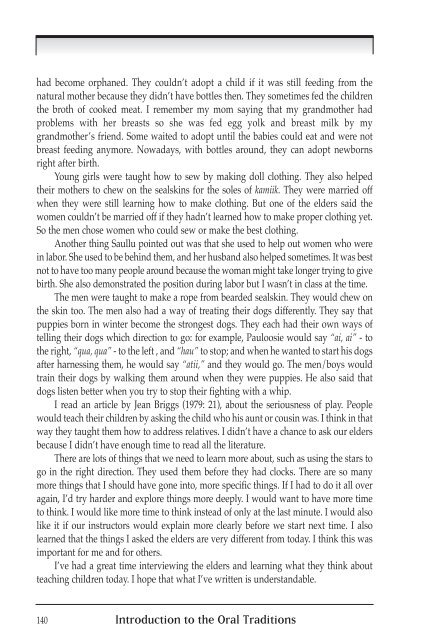Introduction-E
Introduction-E
Introduction-E
You also want an ePaper? Increase the reach of your titles
YUMPU automatically turns print PDFs into web optimized ePapers that Google loves.
had become orphaned. They couldn’t adopt a child if it was still feeding from the<br />
natural mother because they didn’t have bottles then. They sometimes fed the children<br />
the broth of cooked meat. I remember my mom saying that my grandmother had<br />
problems with her breasts so she was fed egg yolk and breast milk by my<br />
grandmother’s friend. Some waited to adopt until the babies could eat and were not<br />
breast feeding anymore. Nowadays, with bottles around, they can adopt newborns<br />
right after birth.<br />
Young girls were taught how to sew by making doll clothing. They also helped<br />
their mothers to chew on the sealskins for the soles of kamiik. They were married off<br />
when they were still learning how to make clothing. But one of the elders said the<br />
women couldn’t be married off if they hadn’t learned how to make proper clothing yet.<br />
So the men chose women who could sew or make the best clothing.<br />
Another thing Saullu pointed out was that she used to help out women who were<br />
in labor. She used to be behind them, and her husband also helped sometimes. It was best<br />
not to have too many people around because the woman might take longer trying to give<br />
birth. She also demonstrated the position during labor but I wasn’t in class at the time.<br />
The men were taught to make a rope from bearded sealskin. They would chew on<br />
the skin too. The men also had a way of treating their dogs differently. They say that<br />
puppies born in winter become the strongest dogs. They each had their own ways of<br />
telling their dogs which direction to go: for example, Pauloosie would say “ai, ai” - to<br />
the right, “qua, qua” - to the left , and “hau” to stop; and when he wanted to start his dogs<br />
after harnessing them, he would say “atii,” and they would go. The men/boys would<br />
train their dogs by walking them around when they were puppies. He also said that<br />
dogs listen better when you try to stop their fighting with a whip.<br />
I read an article by Jean Briggs (1979: 21), about the seriousness of play. People<br />
would teach their children by asking the child who his aunt or cousin was. I think in that<br />
way they taught them how to address relatives. I didn’t have a chance to ask our elders<br />
because I didn’t have enough time to read all the literature.<br />
There are lots of things that we need to learn more about, such as using the stars to<br />
go in the right direction. They used them before they had clocks. There are so many<br />
more things that I should have gone into, more specific things. If I had to do it all over<br />
again, I’d try harder and explore things more deeply. I would want to have more time<br />
to think. I would like more time to think instead of only at the last minute. I would also<br />
like it if our instructors would explain more clearly before we start next time. I also<br />
learned that the things I asked the elders are very different from today. I think this was<br />
important for me and for others.<br />
I’ve had a great time interviewing the elders and learning what they think about<br />
teaching children today. I hope that what I’ve written is understandable.<br />
140 <strong>Introduction</strong> to the Oral Traditions


